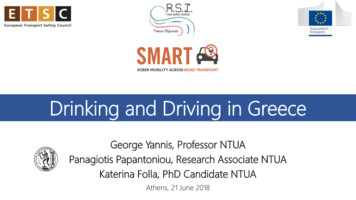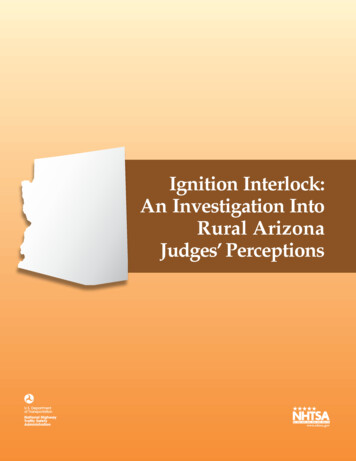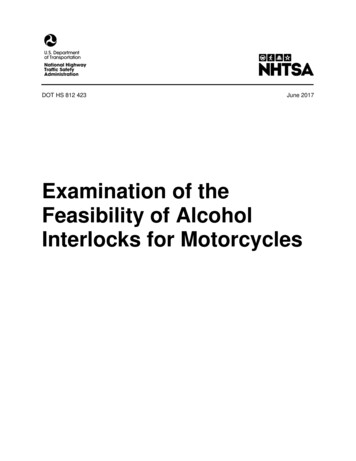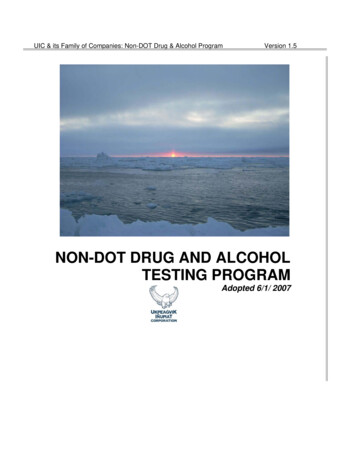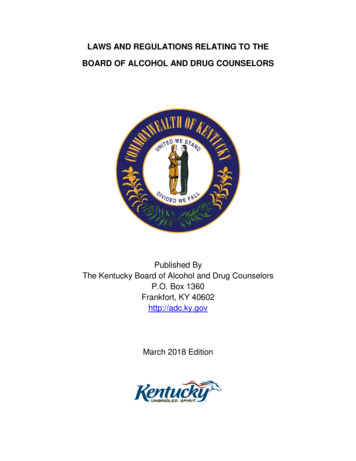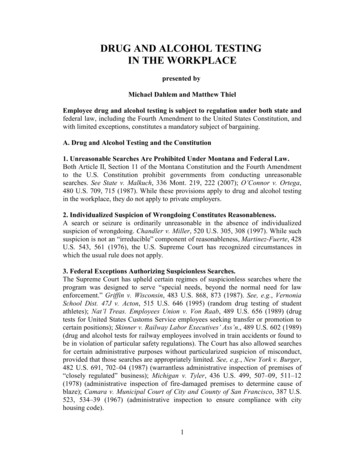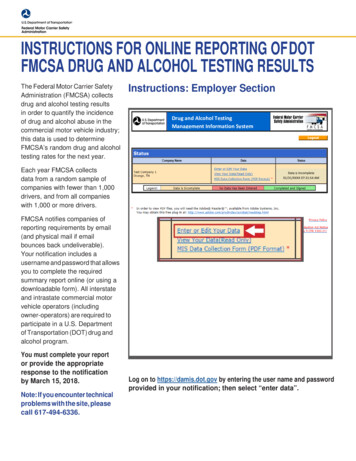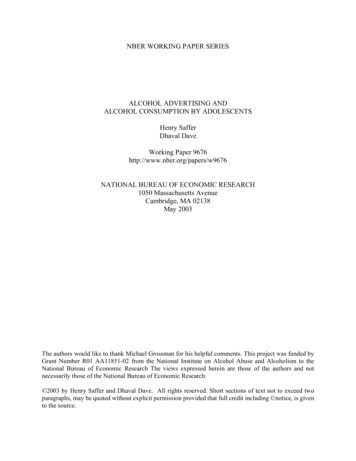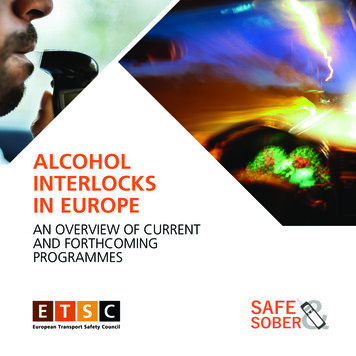
Transcription
AALCOHOLINTERLOCKSIN EUROPEAN OVERVIEW OF CURRENTAND FORTHCOMINGPROGRAMMES
2ALCOHOL INTERLOCKS IN EUROPEACKNOWLEDGEMENTSThis report would not have been possiblewithout the support of the panel of contributingexperts:Dr. Armin Kaltenegger and MagdalenaLeithner, KFV (Austrian Road Safety Board)Anneliese Heeren, Federal Public Service –Mobility & Transport, BelgiumFOR MOREINFORMATIONAnett Callesen, Danish Road Safety AgencyMax Fogdell, Traficom - Finnish Transport andCommunication AgencyDr Charles Mercier Guyon, ETSC expert, FranceJoël Valmain, Adviser for European andInternational Affairs to the InterministerialDelegate for Road Safety, FranceEmanuele Laurenzi, Fondazione Ania, ItalyVidmantas Pumputis, Ministry of Transport andCommunications, LithuaniaDagmara Jankowska-Karpa, Motor TransportInstitute - Road Traffic Safety Centre, PolandPär-Ola Skarviken and Ted Snölilja, SwedishTransport AgencyFrank Norbury, Parliamentary Advisory Councilfor Transport Safety, UKEuropean Transport Safety Council20 Avenue des CeltesB-1040 BrusselsTel: 32 2 230 -sober/This report is published as part of the Safe & Soberproject, which receives financial support fromACS - Alcohol Countermeasure Systems. Thecontents of this publication do not necessarilyrepresent the views of the sponsor. 2020 European Transport Safety Council
ALCOHOL INTERLOCKS IN EUROPEAALCOHOLINTERLOCKSIN EUROPEAN OVERVIEW OF CURRENTAND FORTHCOMINGPROGRAMMESB3
CONTENTSINTRODUCTION5PART I6MANDATORY FITTING OF ALCOHOLINTERLOCKS: INVENTORY OF EUROPEANPROGRAMMES FOR OFFENDERSPART II14RECENT AND FORTHCOMINGPROGRAMMESPART IIIEUROPEAN MAP17
ALCOHOL INTERLOCKS IN EUROPEINTRODUCTION22,660 people were killed in the EuropeanUnion as a consequence of road collisions in2019. Driving under the influence of alcoholis one of the four main killers on the road,alongside speeding, non-use of the seatbeltand driver distraction.Around 2,654 people were recordedkilled in alcohol-related collisions inpolice records in 2018 in 23 EU countries.This figure is likely to be higher due toa high level of underreporting of roaddeaths attributed to alcohol as well asdata collection limitations.1A study commissioned by the EuropeanCommission’s DG MOVE and publishedin 2014 concluded that alcohol interlockscan offer an effective and cost-beneficialimprovement to road safety in Europe,particularly for repeat offenders and incommercial vehicles.2Alcohol interlock programmes give offenderswho would normally lose their driving licencea possibility to continue driving, as long asthey are sober. The ignition interlock devicemakes sure that drivers can only start theengine after having completed a breath testthat has indicated that they are sober. At thesame time the device can collect informationthat can be used to monitor drink-drivingbehaviour.123ETSC has long been in favour of alcoholinterlocks, in particular as part of arehabilitation programme. Studies haverepeatedly shown that the combinationof alcohol interlocks and rehabilitationprogrammes cut reoffending rates. In2016, ETSC set out guidelines to supportauthorities that want to introduce an alcoholprogramme including on legislation, technicaland procedural aspects, rehabilitation,enforcement, costs, piloting and evaluation;and communication.3This new report aims at providing a more practicalapproach with an inventory of long-running alcoholinterlock programmes in Europe, showing how eachcountry has implemented their national scheme. Italso identifies strengths and weaknesses to advocatefor more effective measures and to inspire otherMember States to deliver successful programmes.All the information collated in this publication hasbeen provided by the panel of contributing experts.Other countries have decided to followthis trend and to include alcohol interlockprogrammes in their legal systems. This is thecase in Lithuania, France and Italy. Lithuaniaand France are already running programmes,whereas Italy, after a successful trial, is nowin the legislative process to adopt the law inthe coming months.ETSC (2019), Progress in reducing drink-driving and other alcohol-related road deaths in Europe, https://bit.ly/3kDcICSECORYS (2014), Study on the prevention of drink-driving by the use of alcohol interlock devices, https://bit.ly/3mzuZljETSC (2016) Alcohol Interlocks and Drink-driving Rehabilitation Programmes in the EU. https://bit.ly/2KTAF6H5
6PART IMANDATORYFITTING OF ALCOHOLINTERLOCKSINVENTORYOF EUROPEANPROGRAMMES FOROFFENDERS
ALCOHOL INTERLOCKS IN EUROPEAUSTRIAOFFENDER PROGRAMME4ALCOHOL INTERLOCK COMBINED WITH REHABILITATIONRELEVANTADMINISTRATIONDriving licence administration authorities (an operative coordinatinginstitution (“ABS Institution”) has been created for the purpose of thetrial)TRIALPilot project 2012-2013ENTRY INTO FORCE2017 – 2022 (5 year trial)POSITION IN THE LEGALSYSTEMAdministrativeHOW MANY AI INSTALLEDTODAY?150 - 200 installations per yearOffenders that volunteer based on the following criteria :WHO ? Only category B and BE A suspension of the driving licence for at least four months The expiration of at least half of the suspension period No alcohol addictionThe driver has to meet a mentor every two monthsREHABILITATION /MEDICAL ASPECTS Examination of data readout for violations Discussion of the participant‘s experience with the device Discussionof the driving behaviour in reference to the data readout and driver‘slogbook and development of strategies for a successful continuationof the programme Support with administrative procedures in relation to the DUI offence No mandatory medical or psychological examination (medicalor psychological measures can be required in the revocationproceedings, in this case they have to be fulfilled before entering thealcohol interlock programme)Costs (approximate values)COSTS4 2,500 euros/year for the device 600 euros minimum for the mentoring programme 300 euros to install and remove the deviceGENDER/AGEApproximately 80% menPARTICIPATION RATE No general participation rate can be identified because there are nofigures available of how many are eligible. It can be said that once a candidate is in contact with the ABSinstitution there is a participation rate of nearly 99%EVALUATIONNo official evaluation yet (Evaluation planned after the trial period endsin 2022)Consolidated federal law: Entire legal provision for the Driving License Act - Alternative ProbationSystem Ordinance, version dated November 18, 2020, https://bit.ly/3f6N5ZmParticipants haveto meet a mentoron a regular basisto join the Austrianprogramme.7
ALCOHOL INTERLOCKS IN EUROPE8BELGIUMOFFENDER PROGRAMME5ALCOHOL INTERLOCK COMBINED WITH REHABILITATIONRELEVANT ADMINISTRATIONFederal Public Service – Mobility & TransportENTRY INTO FORCELegislation came into force on 1 October 2010, but only operational since 2013POSITION IN THE LEGALSYSTEMCriminalHOW MANY AI INSTALLEDTODAY?757 (as of 20 October 2020)WHO ? Repeat offenders with a BAC equal or above 1.2 g/l: judges must impose an alcohol interlock (1-3years ), a driving ban (at least 3 months) and rehabilitation tests First offenders with a BAC equal or above 1.8 g/l: judges must impose an alcohol interlock (1-3 years),unless clear justification First offenders with a BAC equal or above 0.8 g/l or repeat offenders with a BAC above 1.2 g/l: judgesmay apply an alcohol interlockPossible exceptions: Judge may exempt one or more vehicle categories This has to be justified Not possible to exclude vehicle category with which the traffic offence has been committed No alcohol interlock for alcohol-dependent people (driving ban for medical or psychological reasons,art.42) After the new law of 6 March 2018: judges use this art.42 more frequentlyREHABILITATION /MEDICAL ASPECTSMonitoring programme with awareness raising about the risks of alcohol, drink driving, recidivism andtechnical aspects of the device. Through data downloads the driver can learn more about their ownbehaviour (they won’t see the data by themselves but the monitoring entity will discuss the resultsregularly with them).Three recognised monitoring entities: VIAS Institute, Psycho Medisch Advies (since September 2018) andNoviter (since July 2019).COSTS 1 year : 3 800 euros Fine : 1,600-16,000 euros Repeat offender: 3,200 - 40,000 euros - The judge can subtract the costs of the alcohol interlock fromthe fineThe evaluation led to a change in the legislation adopted on the 6th of March 2018: judges are no longerfree to decideEVALUATION5 In case of a BAC above 1.8 (they have to give a reason as to why they don’t impose an alcoholinterlock), and In case of severe recidivism ( 1.2BAC) (no exception with a reason is possible), but in every casejudges have the possibility to limit to certain vehicle categories (except the vehicle category withwhich the offence was committed). Exception: no alcohol interlock if the offender is alcohol dependent (in this case there is a licensewithdrawal for physical or psychological reasons).Condamnation à l’éthylotest antidémarrage, https://bit.ly/2ILoptf
ALCOHOL INTERLOCKS IN EUROPEDENMARKOFFENDER PROGRAMME6ALCOHOL INTERLOCK COMBINED WITH REHABILITATIONRELEVANTADMINISTRATIONDanish Road Safety Traffic AuthorityENTRY INTO FORCE2015 – New programme in 2017POSITION IN THE LEGALSYSTEMAdministrativeHOW MANY AI INSTALLEDTODAY?450WHO ?Today approximately450 drivers areparticipating inthe Danish alcoholinterlock programme.6 Voluntary programme: first time offenders with a BACabove 2 g/l, or second time offender with a BAC above1.2 g/l In the voluntary programme the offender canparticipate from day one of the suspension of his drivinglicence. However, if the driver has caused personal injuryor caused serious danger while driving, the driver can notparticipate in the programme. Mandatory programme: second time offenders with aBAC level higher than 1.2 or first time offenders with aBAC level higher than 2.0. If it is the third offence or more,then the BAC level does not matter. In the mandatoryprogramme the offender can participate when thesuspension period is over, which is a minimum of threeyears.REHABILITATION /MEDICAL ASPECTSConsultation compulsory in the voluntary programmeEVALUATIONWhen implementing the programmes the Danish NationalPolice had expected an annual number of participants ofbetween 500 and 1,000. However, an evaluation showedthat there were only 24 participants in the alcohol interlockprogram. This led to a change of the voluntary programmein 2017: before 2017 an alcohol interlock could replacea licence suspension of maximum two years, now threeyears of suspension can be replaced with three years withan alcohol interlock. Today approximately 450 drivers areparticipating in an alcohol interlock programme.The Danish Transport Authority, Alcohol lock and ANT course, https://bit.ly/38XAmqI9
ALCOHOL INTERLOCKS IN EUROPE10FINLANDOFFENDER PROGRAMME7ALCOHOL INTERLOCK COMBINED WITH REHABILITATIONRELEVANTADMINISTRATIONFinnish Transport and Communications Agency TraficomTRIAL2005ENTRY INTO FORCE2008HOW MANY AIINSTALLED TODAY?Approximately 1,000 participants BAC 0.5 - 1.2 g/l : 12-36 months, median 16 monthsWHO ? BAC 1.2 g/l and above: 12-26 months, median 18 monthsTo enter the programme the offenders have to send theirapplication to the police.REHABILITATION /MEDICAL ASPECTSRequirement to meet a health care professional and get acertificate to be provided to the policeCOSTSYear 1: 2,400 eurosYear 2: 1,920 eurosYear 3: 1,440 eurosGENDER / AGEPARTICIPATIONRATE Average age: 51 years old 84% male85% of participants completed the programmeCompleted in 2013 1,687 drivers Average duration: 17 monthsEVALUATION 5.7% of the drivers reoffended during or after the probationperiod whereas the usual recidivism rate for drink-drivingoffenders is 30% The alcohol interlocks have prevented 12,000 participants fromdriving under the influence of alcoholAGEGENDER5184%average agemaleAlcohol interlocks have prevented 12,000 participantsfrom driving under the influence of alcohol in Finland,according to the evaluation of 2013.7Alcohol interlock-controlled driving rights, Traficom, https://bit.ly/3fflbKE
ALCOHOL INTERLOCKS IN EUROPEFRANCEOFFENDER PROGRAMME8ALCOHOL INTERLOCK AS AN ALTERNATIVE TO SUSPENSIONRELEVANTADMINISTRATIONFrench PrefectureTRIAL2018: in seven french departmentsENTRY INTO FORCEExtended to the entire country in 2019POSITION IN THELEGAL SYSTEMAdministrative until a judgement from the courtHOW MANY AIINSTALLED TODAY?Since 1 January 2020, and for the first 9 months, 8,104 prefectoral decreesrestricting driving with an alcohol interlock have been proposed to offenders finedat the roadside by the police, leading to the effective installation of around 1500devices.WHO ?Offenders driving with a BAC above 0.8 g/lThe alcohol interlock can be installed for a maximum duration of one year sinceMay 2020 - it was previously six months (can be extended to five years by thejudge at a later point)Following an alcohol interlock measure as an alternative to licence suspension,the prefecture's medical commission may issue an opinion to the prefect on thereturn of the driving licence, subject to certain conditions being met by the driver:REHABILITATION /MEDICAL ASPECTS To install at their own expense an approved alcohol interlock in the vehicle theydrive; To carry out a medical-psychological follow-up i.e. an addiction consultation(follow-up is limited to this mandatory consultation, without any ongoingmonitoring during the program and no data analysis)Since 2019,the French prefectscan impose analcohol interlockas an alternativeto a driving licencesuspension. Purchase : 1,300 euros Rent : 100 euros/monthCOSTSThe installation and operating costs of the device are the responsibility of thedriver. The price of installation and dismantling in the vehicle must be added.To facilitate the installation of the devices, the french road safety website providesusers with a national map of approved installers by department and region.9No evaluation planned yet but several improvements have been made:EVALUATION This alcohol interlock programme was decided as an alternative to a drivinglicence suspension in order to improve the existing judicial system as it was feltthat the obligation to drive with an alcohol interlock was coming too late in theprocess. In order to combat recidivism, a measure from 9 January 2018, makes itcompulsory to install an alcohol interlock in the event of a repeat offence ofdriving under the influence of alcohol.89Sécurité Routière, l’éthylotest anti-démarrage, https://bit.ly/3jDsFrEMap of approved alcohol interlocks installers by department and region in France : https://bit.ly/3kOWcPw11
12ALCOHOL INTERLOCKS IN EUROPEPOLANDOFFENDER PROGRAMMEALCOHOL INTERLOCK AS AN ALTERNATIVE TO SUSPENSIONENTRY INTO FORCE2015POSITION IN THE LEGAL SYSTEMCriminalHOW MANY AI INSTALLED TODAY?While there is no data available of actual installed alcoholinterlocks the number of court orders is available.However, this decision is not binding and the driver canstill choose the licence suspension afterwards. Offence – 94 in 2017, 303 in 2018, 21 in the 1sthalf of 2019; Crime – 609 in 2017, 2 180 in 2018, 840 in the 1sthalf of 2019Offenders driving with a BAC above 0.5 g/l 0.2-0.5 g/l (offence) above 0.5 g/l (crime)WHO?Offenders may ask the court for their driving ban to bereplaced with an alcohol interlock after at least half ofthe driving ban period has passed. If they had a lifetimedriving ban they can apply for an alcohol interlock afterat least 10 years.REHABILITATION /MEDICAL ASPECTSUnder the Polish regulation, alcohol interlocks are notpart of a rehabilitation programme.EVALUATIONThere are no studies monitoring the effects ofimplementing this solution.The Polish alcohol interlocks programmeis a voluntary solution for all offenderswith a BAC above 0,5 g/l
ALCOHOL INTERLOCKS IN EUROPESWEDENOFFENDER PROGRAMME10ALCOHOL INTERLOCK COMBINED WITH MEDICAL CERTIFICATESRELEVANT ADMINISTRATIONSwedish Transport AgencyTRIAL1999ENTRY INTO FORCE2012Possibility for drink drivers but not compulsoryWHO ? 1 year programme for drivers convicted with a BAC levelbetween 0.2 and 0.9 g/l; 2 year programme for convicted repeat offenders (within a fiveyear period), and offenders with a BAC level of at least 1.0 g/lREHABILITATION /MEDICAL ASPECTSThe programme is not designed to include a rehabilitationaspect but, in many cases, it has shown these kinds of effectsfor the participants anyway. Especially since there is a demandto undergo medical exams, including leaving blood samplesbefore, during and sometimes after participation in theprogramme.COSTSCosts 1 year : 2,000 – 2,700 euros 2 years : 2,800 – 4,000 eurosGENDER / AGE 87% male Average age: 45-54 years old 30% of offenders entered the programme 83% of participants completed the programmeAGEGENDERaverage agemale 31 % of participants had an alcohol-related diagnosisPARTICIPATION RATE45-54 87%EVALUATION1011Due to an infringement procedure from the EU the newlegislation in force as of March 2018 does not allow offenderswith a dependency or an addiction to enter the alcoholinterlock program in Sweden, unless they can prove that theyfulfil all the medical demands beforehand, e.g. prove sobrietysix months prior to entering the programme.Completed in 201811About 3,000 people are currently driving with an alcoholinterlockAlcohol interlock after drink-driving, Swedish Transport Agency, https://bit.ly/3lMVxzxForsman, Åsa, et al. - Evaluation of a Swedish alcohol interlock program for drink driving offenders : Final report, https://bit.ly/3piEN5g13
14PART IIRECENT ANDFORTHCOMINGPROGRAMMES
ALCOHOL INTERLOCKS IN EUROPE1. LITHUANIAIn 2019 the Lithuanian Parliament adoptedan amendment to the law on Road TrafficSafety allowing the Ministry of Transport tolaunch an alcohol interlock programme as apathway to a shorter driving ban for highlevel drink-driving offenders.Since 1 January 2020, convicted drinkdrivers who have lost their driving licenseare, after a set period of time, able to applyfor their license to be reinstated with theprovision that they only drive a vehiclefitted with an alcohol interlock.To date, 400 drivers have participated inthe programme.Vehicles with alcohol interlocks have beenin operation in Lithuania for some time.More than 80 new school buses equippedwith the devices have been handed overto municipalities since 2016. In Vilniusand Kaunas passengers are transportedby shuttle buses equipped with alcoholinterlocks and some freight and passengertransport companies have voluntarilyinstalled the devices on their vehicles.The Ministry of Health intends to create anew rehabilitation programme, which willinclude offenders already included in thealcohol interlock programme allowing amedical follow up for drink-drivers.2. ITALYFROM TRIAL TO LEGISLATIVEPROPOSALChanges to road safety laws in Italy couldlead to the introduction of alcohol interlockprogrammes for drink driving offenders, aswell as updates to numerous road safetyrules.In Italy there were no specific regulations orgovernment-led experiments. For this reasonthe Fondazione Ania launched a project,to be developed in the professional driverssector. In the course of 2018, 53 systemswere installed on a fleet of buses owned byBus Company, a public transport companywith 400 employees, who use 300 coachestravelling about 15 million km per year.The purpose of the trial was to : Test the alcohol interlock systemsand understand their operationalfunctionality Provide information to the insurancesector Prevent negative consequences ofalcohol abuse while driving Reduce the risk of personal injury andproperty damage Strengthen the trust of customers andpassengers Increase the transport sector'sawareness about drink-driving Demonstrate commitment to roadsafety15
16ALCOHOL INTERLOCKS IN EUROPEThe buses equipped with this systemhave covered about 10.4 million km. Themeasurement data are stored in the memoryof the equipment and are not transmitteddirectly to a control centre, as is the casewith "black boxes" for example. Theyare only downloaded in the event of roadaccidents or suspicion that the driver is usingalcohol on duty. Sampling of the systemsdid not reveal any violations. The driversinvolved in the experiment never exceededthe alcohol level required by the HighwayCode (0.0 g/l) for professional drivers andcompany regulations.According to the draft proposal, offendersdriving with a BAC from 0.8 g/l to 1.5 g/lwill have to install an alcohol interlock for 2years, and 3 years with a BAC above 1.5 g/l.This new legal proposal to introduce alcoholinterlocks came from the CNEL (The NationalCouncil for Economics and Labor), a state bodywith the power to propose new legislation,and has been presented to the House ofRepresentatives of the Italian Parliament,marking the first step on the road to adoption.The amendments would supplement article 186and article 125 of the Italian Driving Code.3. UNITED KINGDOMIn its Road Safety Statement 2019, the UKDepartment for Transport undertook toinvestigate the feasibility of using alcoholinterlocks in association with drink driveoffender rehabilitation programmes. TheDepartment for Transport subsequentlyawarded the Parliamentary Advisory Councilfor Transport Safety (PACTS) a grant to leada consortium to undertake the research.A trial of interlock use was conducted in theUK in 2006 and independently evaluated.It was decided not to proceed with wideruse. More recently, a small-scale trial byone police force has been launched and isongoing. The PACTS study has reviewedthese trials and also taken into accountfindings from the trials and programmes inEurope, North America, Australia and NewZealand.With this information, as well as evidencefrom scientific research, PACTS has exploredhow an alcohol interlock programme may beintroduced into the UK, with considerationfor the technical, legal and other essentialprogramme aspects, and overall benefitsthat might be delivered.This report is due to be published in early2021. As part of the recommendations,trials may be proposed as a next step.
ALCOHOL INTERLOCKS IN EUROPEPART IIIEUROPEAN MAPOffender programmesCost-benefit analysis ongoingFeasibility studyLaw in preparationProgramme ended dueto legal technicalities1212The programme was placed under administrative law but offenders were sanctioned by the courts as well and this sentence could interfere withthe alcohol interlock measure: ETSC (2016) Alcohol Interlocks and Drink-driving Rehabilitation Programmes in the EU. https://bit.ly/2KTAF6H17
18ALCOHOL INTERLOCKS IN EUROPEDISCUSSION:STRENGTHS AND WEAKNESSESThe national experts that contributed to thisresearch described some of the strengthsand weaknesses of the alcohol interlockprogrammes they have worked on.Effective programmesimpacts such as:showedpositive securing the jobs of people who reliedon being able to drive for work; making drivers aware of theirresponsibilities; helping offenders remain integratedin society (although participation issometimes perceived as a constraint);Two key elements for a successful programmestood out: rehabilitation measures andaffordable costs.Some countries have adopted rehabilitationmeasures in combination with alcoholinterlocks leading to positive outcomes.According to an evaluation published in2013, the Finnish programme has prevented12,000 participants from driving under theinfluence of alcohol. Various evaluationsof driver rehabilitation courses for drinkdrivers indicate that the recidivism ratecan be reduced by 50%. Experts fromcountries without rehabilitation or mentoringcombined with alcohol interlocks deploredthe lack of monitoring and advocate for theadoption of rehabilitation courses. Belgianresearchers concluded that the Belgianalcohol interlock programme should beexpanded to include close monitoring .Alcohol interlock programmes should involvenot just the installation of the device itself,but also include a coordinated set of activitiesdesigned to minimise recidivism.Experts largely agreed that the high costfor the installation and maintenance of thedevices is one of the main reasons for thelow participation rate. The costs constitutea real barrier for many offenders to enteran alcohol interlock programme (when theyhave the possibility to choose between alicence suspension and an alcohol interlock).Lower costs could bring real benefits with anincrease of participants and a consequentialdecrease in re-offending.Lastly, it has been pointed out that asignificant group of potential participantsare excluded as the EU directive on drivinglicences does not allow people with an alcoholdependency to be allowed to continue drivingwhile participating in an alcohol interlockrehabilitation programme. Including them,with medical supervision would increaseparticipation in the programmes and cutrecidivism.
20European Transport Safety Council20 Avenue des CeltesB-1040 Brusselsinformation@etsc.euTel: 32 2 230 4106www.etsc.eu@ETSC EU
7 Alcohol interlock-controlled driving rights, Traficom, https://bit.ly/3fflbKE Alcohol interlocks have prevented 12,000 participants from driving under the influence of alcohol in Finland, according to the evaluation of 2013. average age 51 male 84% AGE GENDER. ALCOHOL INTERLOCKS IN EUROPE 11
